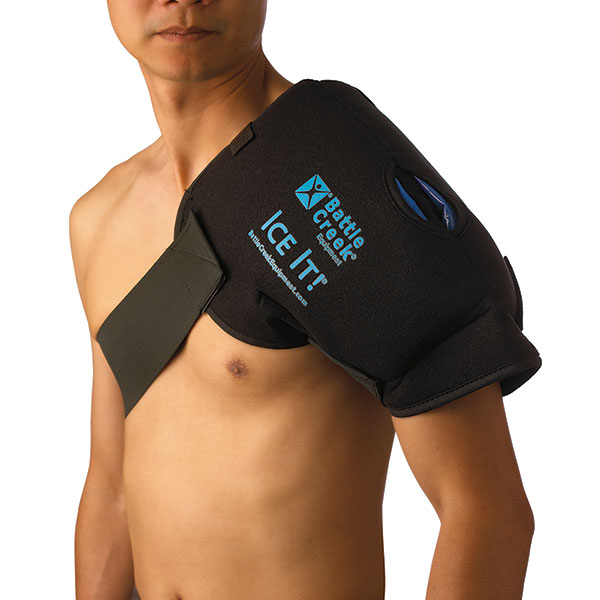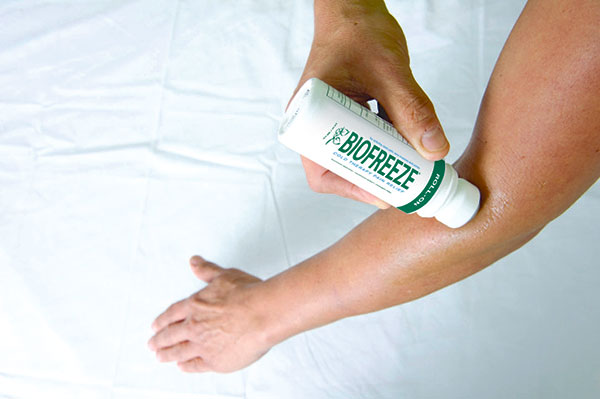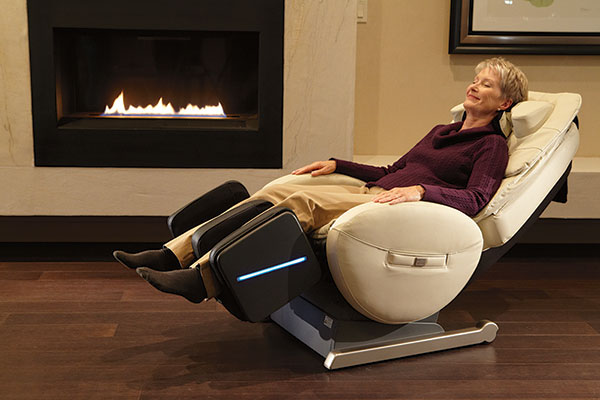Pain is personal; everyone experiences it differently. Pain is also universal. We all either have pain or know someone who does. When talking to Baby Boomers, how long before the subject of pain comes up? When one person mentions it, everyone typically joins in with their own struggles.
For HME/DME providers, the pain management category offers the potential for growth in cash sales, with products ranging from topical ointments to hot/cold therapies to technology products such as transcutaneous electrical nerve stimulation (TENS) units and even laser therapy.
Complementing the pain management category are orthopedic softgoods, which also have a pain relief component, and even massage chairs (see sidebar).
According to the Institute of Medicine’s 2011 “Relieving Pain in America” report, about 100 million American adults suffer from chronic pain, which costs up to $635 billion per year in medical treatment and lost productivity—a cost level higher than that for cancer, heart disease and diabetes combined. The IOM’s report urges health care providers to increasingly tailor pain care to each person’s experience and to promote self-management, which is where HME providers can help. What percentage of the huge number of chronic pain sufferers either currently overlaps with the HME/DME customer base or one day will?
Many HME/DMEs are looking to leverage their established, trusted relationships with customers to expand into the pain relief category. “If you can address that, you open a whole new market that many DMEs haven’t touched,” says Kathy Gallivan, vice president of distributor relations,
Renewal Technologies, supplier of the LaserTouchOne alternative pain relief device. She says pain management can provide a way to shift and expand an HME/DME business. “We don’t harm anyone,” says Gallivan. “You have nothing to lose but pain. It’s universal. Everybody hurts in some fashion.”
Educating the Customer
Jim Greatorex, president of Black Bear Medical in Portland, Maine, is one provider who continues to grow a successful pain management business. “It’s pretty much an education of the consumer,” he says. “We deal with people who walk in and know very little about the products. Making people aware of the options is how you sell products. You come across as a problem-solver, not a salesman. People will open their wallets for a product that helps them with pain.
“A lot of people who suffer from pain are not getting the results they want from the clinical end,” he continues. “Physicians are trained to provide pills and perform procedures.” To provide an alternative, HME/DMEs can become the customer’s partner in finding a more holistic approach to pain management. “That’s what’s good about being in the pain reduction business.”
Black Bear Medical gets about 48 percent of its revenue from complex rehab, although in a sparsely populated state like Maine, HMEs have to be diverse. Black Bear also has a healthy disposable supplies business (incontinence, ostomy and urology). Retail, including pain management, is about 33 percent of the business. “It’s going back to Business 101,” says Greatorex. “You have to actually have marketing plans and a business plan, and you’re not being held up by the government. You’re in control of the pricing and whether you’re successful or not depends on how well you market and execute.” Greatorex spoke about retail to a standing room only crowd at Medtrade Spring in Las Vegas.
Laser Technology
 Greatorex’s biggest seller in pain management is the LaserTouchOne by Renewal Technologies. LaserTouchOne combines cold laser and micro-current technology to provide effective pain reduction. In one study, 91.6 percent of carpel tunnel syndrome patients experienced significant pain relief as well as cost savings. Another study confirmed the effectiveness of low-level laser therapy to increase production of ATP (adenosine triphosphate), a molecule necessary for cellular repair and healing. LaserTouchOne offers dual-modality, which combines the benefits of a cold laser device and a micro-current electrical stimulation (TENS) device. The U.S. Food and Drug Administration (FDA) has cleared the product’s dual modality for prescription and over-the-counter sale. Retailing for $489 (with an attractive margin for dealers), the handheld and portable device is about the size of an electric toothbrush, uses a real laser, has a rechargeable battery and is wireless.
Greatorex’s biggest seller in pain management is the LaserTouchOne by Renewal Technologies. LaserTouchOne combines cold laser and micro-current technology to provide effective pain reduction. In one study, 91.6 percent of carpel tunnel syndrome patients experienced significant pain relief as well as cost savings. Another study confirmed the effectiveness of low-level laser therapy to increase production of ATP (adenosine triphosphate), a molecule necessary for cellular repair and healing. LaserTouchOne offers dual-modality, which combines the benefits of a cold laser device and a micro-current electrical stimulation (TENS) device. The U.S. Food and Drug Administration (FDA) has cleared the product’s dual modality for prescription and over-the-counter sale. Retailing for $489 (with an attractive margin for dealers), the handheld and portable device is about the size of an electric toothbrush, uses a real laser, has a rechargeable battery and is wireless.
Renewal Technologies’ Kathy Gallivan says HME/DMEs are a perfect channel to sell the Laser TouchOne. The product is currently sold through more than 100 HME/DMEs nationwide, built on exposure and dealers who learned about the product at Medtrade, where the company has been exhibiting since 2011. Recruiting new dealers involves demonstrating the effectiveness of the product, she says. “We get them to sit down and do a demo. We all have some kind of pain, and the demo sells them on the concept. They are looking to get into the retail business, and pain management is a way to get started.”
“We work at the cellular level with LaserTouchOne to allow the body to heal itself,” adds Gallivan. She says the TENS functionality blocks pain temporarily, while the cold laser facilitates repair and healing. “The dual modality works better than either of the single modalities, with an overall effectiveness of 93 percent.”
LaserTouchOne appeals across multiple age brackets and demographics; it is attractive to athletic trainers, weekend warriors and active young adults as well as to Baby Boomers and older patients, Gallivan says. “It can bring a whole new client base to a DME store. It sounds too good to be true, and that’s the hard part of it. But we have a 1 percent return rate, and we sell thousands of units.”
TENS Disrupts Pain
TENS technology can be another profitable pain management category for HMEs. For example, one TENS product is the Active Knee TENS System by Empi, a DJO Global company, used to treat knee pain that affects more than 19 million Americans. TENS uses comfortable electrical stimulation to inhibit pain signals from reaching the brain, thus effectively blocking the pain sensation. Another product, the Empi Active Back, uses the same proprietary TENS waveform to address back pain.
Core Products International offers the WiTouch and WiTouchPro wireless remote-control pain relief devices incorporating TENS technology to target back pain. Core Products is the exclusive U.S. distributor of the products, manufactured by Chattanooga, Tenn.-based HollyWog. The thin and flexible design of the WiTouch contours to the surface of the back for a perfect fit. Other features include advanced electronics and compact design, and energy efficiency provides more than 150 30-minute treatment sessions per battery. The device can be worn under clothing and remotely controlled to provide treatments throughout the day. Approved by the FDA for over-the-counter sales, the product sells for $149 each (and the low price encourages customers to buy multiple units).
Philip Mattison, president of Core Products International, says demonstrating the product leads to sales. “If they experience it, they will buy it on the spot. Relaxing the sore, tired muscles provides instant relief from pain.” TENS nerve stimulation disrupts nerve signals to the brain and also mildly stimulates and works muscles to increase relaxation.
Mattison says HMEs can increase retail sales by replacing the word “patients” with “customers” in their thought processes, which suggests a higher level of service expectation. For example, Core Products offers a complete guarantee of satisfaction. Core Products also offers a range of orthopedic softgoods and supports, including cervical pillows, massage therapy, hot and cold therapy, extremity supports, back support belts, back rests, rolls and cushions and other products.
Core Products provides 2- or 4-foot planograms, or products can be chosen à la carte. Countertop displays are shipped pre-assembled with a header card. “You can offer a broad selection of pain management products easily and affordably, service a broader selection of customers, improve store traffic, increase sales and get paid in cash,” Mattison says.
 Hot and Cold Therapy
Hot and Cold Therapy
Hot and cold therapy can also provide drug-free pain relief, as well as a sales opportunity for HME/DMEs. At a minimum, it can help reduce the need to take drugs; in the best cases, it eliminates the need altogether, says David Underhill, president of Battle Creek Equipment Company. The supplier offers products that provide hot or cold therapy, including electric moist heat packs (Thermophore), microwaveable moist heat packs (Good2Go), cold therapy wraps (Ice It!) and Pedlar light exercise products.
Consumers may not know they have choices, says Underhill. “Virtually every consumer who walks into an HME store is an opportunity to sell pain relief, and to win the confidence of a customer for years to come.”
“We have seen great results with HME providers who have placed a planogram of hot and cold products in their stores,” says Underhill. Even a 2-foot offering of well-organized products in retail-friendly packaging makes it easy for a consumer to buy and enables an HME store to look like it is “in the pain management business,” says Underhill. “If there are only a few pain management products on the shelf and they don’t look like a representative offering, the consumer is likely to look elsewhere.”
Topical Analgesics
Topical analgesics are another alternative to deliver safe and effective pain relief and can be used independently or in addition to oral pain medicines. Topical analgesics are an excellent choice for those wanting to avoid the adverse effects linked to systemic pain relievers, according to Doug Stuckey, senior product manager, topicals, Performance Health. Researhasshown that NSAIDs, COX-2 inhibitors and opioids can negatively affect the gastrointestinal tract, heart, kidneys and/or other organs, as well as cognition.

Biofreeze pain reliever is a clinically used and recommended topical analgesic with USP-grade menthol as the active ingredient, providing short-term pain relief to promote faster, long-term healing and recovery. Biofreeze pain relief is effective in all phases of rehab or exercise, including in-clinic, at home or on the go.
An application of Biofreeze results in low levels of systemic absorption and therefore less risk for toxicity and/or drug interaction. Stuckey cites 12 studies in the past five years confirming Biofreeze’s efficacy. HMEs can also increase their confidence in the product, and witness first-hand the market potential, by visiting the Biofreeze Facebook page, where numerous posts of unsolicited user experiences document meaningful pain relief from Biofreeze.
Because of a channel commitment to distributors, Biofreeze Pain Reliever is not sold through mainstream retail channels, and therefore can only be offered through HMEs that do not also have pharmacies.
Fast Freeze is another topical product that offers muscle pain relief, joint pain relief, arthritis pain relief and more. It “freezes” pain instantly with natural ingredients such as menthol, camphor, aloe, vitamin E and ilex and is an anti-inflammatory. It is available in gel, spray and roll-on application types.
Orthopedic Softgoods
Another category related to pain management is orthopedic softgoods, which can help prevent and treat a variety of upper and lower-extremity issues, from carpal tunnel to tendonitis and arthritis. Orthopedic softgoods can offer support, assist in proper positioning and provide compression and circulation benefits, all of which can be helpful in preventing and relieving pain.
Orthopedic softgoods are an excellent complement to other pain management solutions. Easy to use, widely available and noninvasive, they can be a critical component in patients’ treatment plans and daily lives. “Many patients would rather try to treat a problem like carpal tunnel with stretching, workplace modifications and a wrist splint than to undergo an invasive procedure such as carpal tunnel release surgery,” says Kylia Garver, Brownmed’s director of marketing.
In business for nearly 50 years and specializing in orthopedic softgoods, Brownmed was launched following Ivan E. Brown, M.D.’s invention of the first aluminum foam finger splint. Today the company has more than 20 patents with several more pending.
Garver says HMEs can sell more softgoods by encouraging a two-tiered approach to treatment, addressing treatments needed during the day and at night. A patient with carpal tunnel might wear a wrist brace at night and a different product in the day. Plantar fasciitis/heel pain, tennis elbow and other conditions also have day and night-time treatments. “Patients who manage and treat their condition around the clock will typically experience faster healing while lessening the possibility of the pain becoming chronic,” says Garver. She also says HME providers should look closely at product quality. Finding patented products or ones with novel patient comfort features or benefits (such as the Arthritis Foundation’s Ease of Use Commendation) can ensure an HME provides the very best in orthopedic softgoods.
Pain-Free Surfing
Battle Creek Equipment Company
www.battlecreekequipment.com
Biofreeze
www.biofreeze.com
Black Bear Medical
www.blackbearmedical.com
Brownmed
www.brownmed.com
Core Products
www.coreproducts.com
Empi
www.empi.com
Fast Freeze
www.fastfreeze.com
Inada
www.inadausa.com
Renewal Technologies
www.lasertouchone.com
The $8,000 Impulse Purchase
 Massage chairs are a perfect complement to pain management, and Cliff Levin, president of Inada USA, says displaying a single massage chair can transform an HME store into a “wow” experience. “Unbelievably, this is an impulse purchase.”
Massage chairs are a perfect complement to pain management, and Cliff Levin, president of Inada USA, says displaying a single massage chair can transform an HME store into a “wow” experience. “Unbelievably, this is an impulse purchase.”
“HMEs who get customers to try an Inada massage chair are shocked at the number of opportunities they have to make an $8,000 sale,” says Levin.
“Also, from a retail perspective, this is an opportunity for the DME industry to provide an experience that isn’t standard DME fare. The product draws a huge amount of attention and creates a buzz.”
Inada’s Sogno DreamWave massage chair, which sells for $8,999 MSRP (with a “lowest advertised price” of $7,999) performs a gentle or an intense massage, designed by a Japanese shiatsu massage therapist, including air pressure massage of body extremities such as calves, ankles and feet. The chair even provides gentle neck traction to ease neck pain.
Inada emphasizes a structured sales approach for massage chairs, using a proven script that maximizes sales, starting with a customer sitting down in the chair. “Very few products are presented to merchants with a very clear roadmap to success,” says Levin. “We have this sales model that we know is effective.”
Inada also offers the Yu•Me, a rocking massage chair, but Levin says the intense massage it offers might not be appropriate for DME customers.
